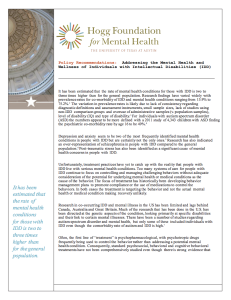Policy Recommendation: Addressing the Mental Health and Wellness of Individuals with Intellectual Disabilities
Background
It has been estimated that the rate of mental health conditions for those with IDD is two to three times higher than for the general population. Research findings have varied widely with prevalence rates for co-morbidity of IDD and mental health conditions ranging from 13.9% to 75.2%. The variation in prevalence rates is likely due to lack of consistency regarding diagnostic definitions and assessment instruments, small sample sizes, lack of studies using non-IDD comparison groups and overuse of administrative samples (v. population samples), level of disability (IQ) and type of disability. For individuals with autism spectrum disorder (ASD) the numbers appear to be more defined with a 2011 study of 4,343 children with ASD finding the psychiatric co-morbidity rate by age 16 to be 49%.
Depression and anxiety seem to be two of the most frequently identified mental health conditions in people with IDD but are certainly not the only ones. Research has also indicated an over-representation of schizophrenia in people with IDD compared to the general population. Post-traumatic stress has also been identified as a significant cause of mental health concerns in people with IDD.
Unfortunately, treatment practices have yet to catch up with the reality that people with IDD live with serious mental health conditions. Too many systems of care for people with IDD continue to focus on controlling and managing challenging behaviors without adequate consideration of the potential for underlying mental health or medical conditions as the cause of the behavior. The focus of treatment has historically been developing behavior management plans to promote compliance or the use of medications to control the behaviors. In both cases the treatment is targeting the behavior and not the actual mental health or medical condition making recovery unlikely.
Research in co-occurring IDD and mental illness in the US has been limited and lags behind Canada, Australia and Great Britain. Much of the research that has been done in the U.S. has been directed at the genetic aspects of the condition, looking primarily at specific disabilities and their link to certain mental illnesses. There have been a number of studies regarding autism spectrum disorder and mental health, but only some of these included individuals with IDD even though the comorbidity rate of autism and IDD is high.
Often, the first line of “treatment” is psychopharmacological, with psychotropic drugs frequently being used to control the behavior rather than addressing a potential mental health condition. Consequently, standard psychosocial, behavioral and cognitive behavioral treatments have not been comprehensively studied even though there is strong evidence that“many individuals gain benefit from these interventions.”
When individuals don’t receive appropriate treatment for mental illness, crises can occur. Even when appropriate services are available, crises can develop. Consequently, it is important to look at the spectrum of mental health services that are needed by people with IDD. We need to do all we can to prevent individuals from reaching the crisis stage, but we also must be prepared to support individuals and families when they do.
There are a number of challenges that have limited our progress in addressing the mental health needs of people with IDD. The challenges, however, should not deter our determination to fix the problems.
Download the full document.

